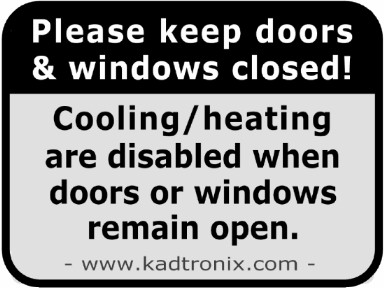Notes:
- Though installation is not difficult, a qualified HVAC technician is recommended.
- System includes two (2) door/window sensors. (Add-on sensors also available.)
- Wireless sensors are battery-operated.
$219.00 – $434.00Price range: $219.00 through $434.00
Shut off cooling / heating when a monitored door or window remains open!
| Discounts | Qty | Price |
|---|---|---|
| buy 2 / save 10% | 2 | 10% $197.10 |
| buy 3 / save 15% | 3 + | 15% $186.15 |
| The HVAC Smart Relay Switch (HSRS) is an energy saving device designed to automatically shut off air conditioning or heating when a monitored door or window remains open for a preset period of time. |
| Fully configurable using onboard DIP switches, the HSRS allows you to easily set desired operational parameters. For instance, configure the device to temporarily disable the air conditioning or heating system when any door or window has remained open for 10 minutes, and then re-enable when the door has remained closed for 1 minute. |
| Available in both wired & wireless packages, the system uses compatible door/window sensors – two included. We offer two RF wireless systems: |
Choose one of the following wireless sensors: |
| Discounts for quantity purchases (computed automatically at checkout). Special pricing available to contractors and resellers (click here for details)! Buy today and get free shipping on your order – no minimum purchase! (*Any U.S. destination, excluding AK & HI.) |

Notes:
(Note: Installation by a qualified hvac technician is recommended.)

Notes:
[/vc_column_text]
| Weight | 3 lbs |
|---|---|
| For HVAC system | Central (split, ducted), Mini-split (ductless), Packaged (rooftop, etc.), Fan coil, PTAC, Window unit, Other (pls contact us) |
| Door/window sensor | Wireless X10: (all door types), Wireless mini: (wood doors only), Wireless basic: (wood doors only), Wired reed switch: (all door types) |
| Sensor quantity | 2, 4 (+$85), 4 (+$59) |
You must be logged in to post a review.
Dan (verified owner) –
I have used a similar system in a couple locations over the last ten years in vacation rental condos. They really work to reduce your utility bills. The thing I like about the Kadtronix system is it allows you to use any thermostat you want. The other systems require you to use their t-stat. I like the combination of door sensors to shut off HVAC when doors are left open. Very good people to work with.
Tara Urban (verified owner) –
I found Kadtronix through a google search when I was looking for an HVAC switch to help me control how energy is used in our vacation home when guests leave the external doors open while the central air is on. My HVAC tech asked me to purchase and he would install. I made a few calls to Kadtronix and spoke with Ken who was extremely helpful and patient. At one point he even took the information I had, so that he could research compatibility with the products he sells. He also ensured after I ordered, that the items I purchased showed up in the time frame I needed them. I would recommend Ken and his company over and over. It’s hard to find good prompt customer service and Ken has it mastered. Look forward to future business with this company.